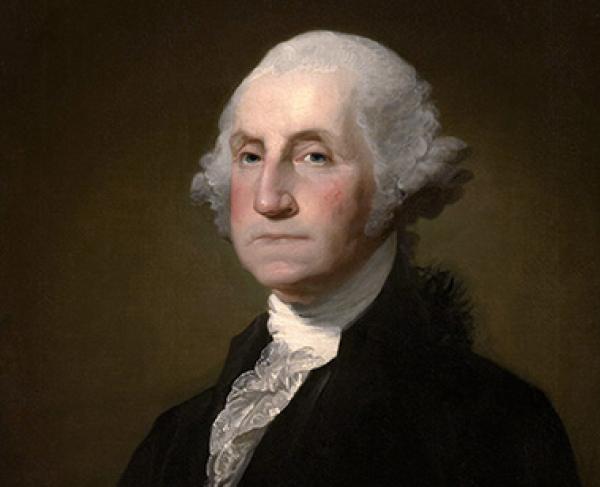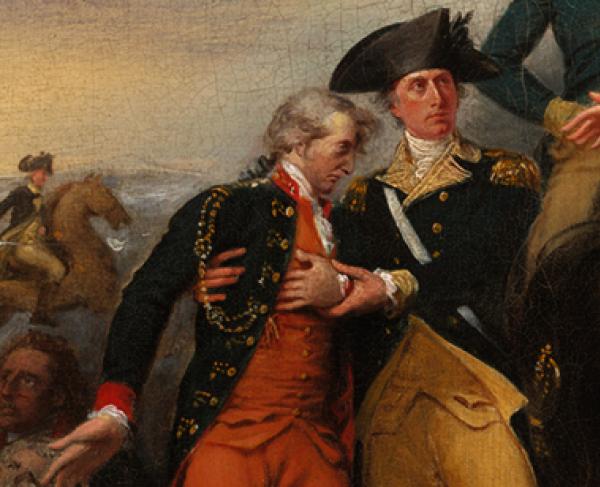
Trenton
New Jersey | Dec 26, 1776
After crossing the Delaware River in a treacherous storm, General George Washington’s army defeated a garrison of Hessian mercenaries at Trenton. The victory set the stage for another success at Princeton a week later and boosted the morale of the American troops.
How it ended
American victory. The army that the British thought was all but defeated destroyed a major garrison and suffered very few casualties. The Americans also managed to capture critical supplies, including food and clothing, in the process. Emboldened, General George Washington recrossed and crossed the Delaware again over the next week, fighting a delaying action at the Battle of the Assunpink and winning another stunning victory at the Battle of Princeton.
In context
In late 1776, morale in the Continental Army was at a low after losses at the Battle of White Plains in October and at Forts Washington and Lee in November. Chased by the British, General Washington retreated across New Jersey and into Pennsylvania. His force, in threadbare uniforms and many without shoes, was reduced to a few thousand and enlistments were set to expire. By December, the troops were huddled along the western banks of the Delaware River, with the waterway and winter weather helping to keep the British at bay. Thomas Paine’s The American Crisis was passed around campfires, reigniting a passion for the revolutionary cause and helping to steady the soldiers’ spirits and resolve.
On the night of Christmas, December 25, 1776, Washington implemented at audacious plan that would improve the fortunes of the American forces. The general daringly led his men across the icy Delaware River and on a ten-mile march into Trenton, New Jersey, where they surprised a garrison of 1,500 Hessians. The Americans dominated the fight and prevailed again in Princeton a week later. In these battles, Washington demonstrated his ingenuity and resilience as a leader, won the loyalty of his soldiers, and revived the Continental Army.
After asking his enlisted men to stay for one last effort, Washington devises a daring plan to stun the British, capture supplies, and reinvigorate American morale. The objective is to ferry his army across the Delaware River on Christmas and strike the Hessian garrison at Trenton. Initially devised as a three-pronged attack, the scheme is foiled by a nor'easter and the ice choked river, which cause two of Washington's columns to turn back. Only the main army, with Washington at its head, makes the arduous crossing nine miles to the north of Trenton.
December 26. Behind schedule because of the storm, the Americans arrive on the outskirts of Trenton around daybreak. Washington splits his force into two columns. One, commanded by Major General Nathanael Greene, attacks from the north, while a second, under Major General John Sullivan, attacks from the west to cut the line of retreat to the south.
The Hessian garrison, under the command of Colonel Johann Rall, had been harassed by American militia for several weeks and the men are exhausted. Although Washington engages the pickets on the outskirts of town, Rall is taken completely by surprise. A running fight through Trenton is a decidedly one-sided affair. Some Hessians manage to escape, but most are captured. While leading his troops, Rall is mortally wounded. Before he dies, he formally surrenders to Washington.
5
905
The success at Trenton encourages Washington to cross the Delaware for a second time a week later to lure British forces south from Trenton. In doing so, the Americans gain an advantage and are again victorious at the Battle of Princeton. In these engagements, Washington proves he is capable of molding militias from different colonies into a national force. Afterwards, the Continental Army marches to Morristown to settle in for the winter.
The logistics of crossing a roiling river at night with thousands of men, horses, ammunition, and 18 canons were complex. The odds of accomplishing such a crossing in a winter gale were not favorable. Fortunately, the treacherous river crossing that enabled Washington to conduct a surprise attack on the Hessian garrison in Trenton was successful, but it did not go as the commander had planned. Originally, the general had intended for there to be three crossings on Christmas night: one by Colonel Cadwalader’s Philadelphia militia and a group of Continentals, another by General James Ewing’s Pennsylvania militia, and the last, by Washington’s 2,400 soldiers. The idea was for the three forces to take up different positions on the opposite shore, contain the Hessians, and prevent their retreat from Trenton. But this ambitious strategy was foiled by the weather. Cadwalader’s and Ewing’s men could not navigate the icy river. Washington miraculously got through the howling wind and driving sleet, but with a three-hour delay that threatened to expose his men to discovery by the enemy. He had no option but to push on.
Washington’s crossing through the raging nor’easter that night relied on good boats and able men. Most of the American force was transported in strongly built Durham cargo vessels, which had a shallow draft and were 40 to 60 feet in length. These craft were typically used to move iron ore down river. They were sturdy and had high side walls. Heavy artillery and horses were taken across on flat-bottomed ferries. Experienced sailors from Colonel John Glover’s Marblehead regiment, all able seamen from Massachusetts, expertly guided the vessels, aided by local watermen who knew that stretch of the Delaware River well. And that stretch—contrary to what one sees in the most famous depiction of the event, Emanuel Leutze’s painting Washington Crossing the Delaware—was not wide. It was only 300 yards at the point the army crossed. Still, moving a large body of men and heavy artillery across an icy river took guts and stamina. Washington and his men proved they had both. And when they arrived on the New Jersey shore, they still had to march ten more miles through the ice and snow to fight the Hessians.
Despite being warned of the Continental Army’s imminent assault on Trenton on December 26, 1776, Colonel Johann Rall did nothing to fortify the city. “Let them come,” he said. “We will go at them with the bayonet.” Rall’s Hessian troops had defeated Washington’s forces many times before. He had nothing but disdain for the Americans’ abilities in battle.
Rall, 50 years old at the time of the Trenton attack, was an accomplished soldier with 36 years of experience in the Hessian army. He was revered as an empathetic leader by those who served under him but disliked by his superiors, many of whom were younger and of more aristocratic backgrounds. They felt Rall was crude and lacked respect for their authority. This disregard for those in command, contributed to Rall’s behavior in Trenton.
When British General William Howe decided to shelter for the winter, he created a chain of 17 outposts across New Jersey, including three along the Delaware River in Burlington, Bordentown, and Trenton. Thirty-six-year-old Colonel Carl von Donop was given the overall command of the Delaware River posts, and Rall was appointed commander of Trenton. Von Donop and Rall didn’t like one another. So, when von Donop ordered Rall to erect fortifications around Trenton, which was considered the most exposed of the three Delaware River sites, Rall simply ignored him.
Despite his bravado, Rall was actually getting nervous about a possible attack on Trenton. Since mid-December, his troops had been under constant perimeter attacks from the New Jersey-based Hunterdon Militia and General James Ewing’s Pennsylvania Militia, which was stationed directly across the river. Rall’s men were exhausted, and the colonel knew, of course, that Trenton was indefensible. Rall sent messages to von Donop and General James Grant, the British commander of New Jersey, asking for support but his requests were denied. So, it was up to Rall and his weary troops to bear the burden of an American assault. As Rall lay dying from his wounds after the battle, he asked Washington, who had come to receive his surrender, to treat his captured men with humanity. Washington graciously complied.
Trenton: Featured Resources
All battles of the New York and New Jersey Campaign
Related Battles
2,400
1,500
5
905











